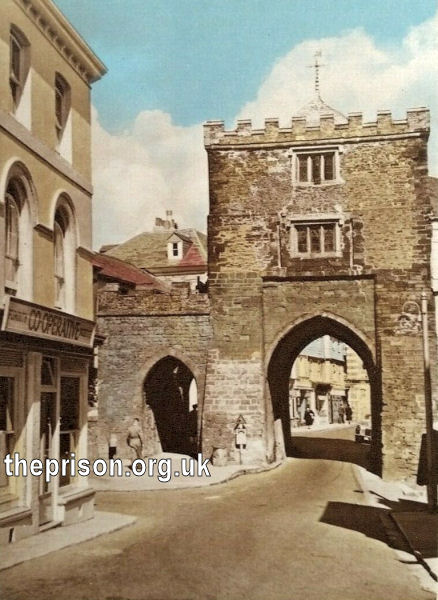Town Gaol, Launceston, Cornwall
In around 1800, a Town Gaol was established in the South Gate at Launceston.
In 1812, James Neild wrote:
This Gaol, called very appropriately "The Dark House," stands over the South Gate; and the ascent to it is by a flight of steps.
Debtors are sent hither by process issuing out of the Borough Court, for sums to any amount: a Court is held every three weeks.
The Prison is in a most filthy and dilapidated state. About a fortnight before my visit in 1803, a Debtor had made his escape very judiciously; and none have have been sent there since. Upon asking the Keeper when it had been cleaned and white-washed, I well remember his telling me "that he had frequently applied to the Mayor of Launceston to have it done; but the answer was, 'The blacker it is, the better : It has more the appearance of a Gaol'."
The room over the gateway, 15 feet by 11, for Criminals, has an iron-grated window towards the street, with an inside shutter; and two sleeping-cells, which open into the room, each about 7 feet square, and 8 feet high; the doors only four feet high, and fifteen inches wide.
Over this room is another, 22 feet by 18, assigned as a Gaol for Debtors! the only light it can possibly receive is from two opposite apertures in the wall, of about 3 feet by 9 inches. And that light, as if envied the quondam inhabitants, almost totally annihilated, by an iron bar placed lengthwise; just enough to tantalize the insolvent victim of such obscurity! Straw lies scattered over the floor; and here is a fire-place, but no fuel is allowed. To recompense such denial of luxury, however, a half tub effectually supplies the place of a necessary.
No court-yard. No water! but the Constable brings it, when wanted, thrice a day.
Gaoler, the Town Sergeant. No Salary. No Fees. I have not met with any Debtors here at my several visits; and in 1806 the three Criminals were out upon Bail, Allowance, two-pence a day

South Gate, Launceston, Cornwall.
The poor state of the accommodation was recorded in a report in 1835:
The Gaol of the borough is quite unfit for the abode of any description of persons; it consists of one room and two cells, and an upper room exclusively appropriated for the use of debtors; there is no yard attached to it, nor any means of exercise for the prisoners. It was stated by the town clerk that the inhabitants would not pursue their debtors in the civil court, lest they should cause them to be confined in the gaol, and that it was impossible to give an adequate supply of air to the prisoners, or to attempt to give labour or instruction to the persons confined.
The prison was officually closed in 1884 though had been rarely used since the 1830s.
Records
Note: many repositories impose a closure period of up to 100 years for records identifying individuals. Before travelling a long distance, always check that the records you want to consult will be available.
- Cornwall Archives, Kresen Kernow, Little Vauxhall, Redruth TR15 1AS.
- The National Archives, Kew, Richmond, Surrey, TW9 4DU. Has a wide variety of crime and prison records going back to the 1770s, including calendars of prisoners, prison registers and criminal registers.
- Find My Past has digitized many of the National Archives' prison records, including prisoner-of-war records, plus a variety of local records including Manchester, York and Plymouth. More information.
- Prison-related records on
Ancestry UK
include Prison Commission Records, 1770-1951
, and local records from London, Swansea, Gloucesterhire and West Yorkshire. More information.
- The Genealogist also has a number of National Archives' prison records. More information.
Census
Bibliography
- Higginbotham, Peter The Prison Cookbook: A History of the English Prison and its Food (2010, The History Press)
- Brodie, A. Behind Bars - The Hidden Architecture of England's Prisons (2000, English Heritage)
- Brodie, A., Croom, J. & Davies, J.O. English Prisons: An Architectural History (2002, English Heritage)
- Harding, C., Hines, B., Ireland, R., Rawlings, P. Imprisonment in England and Wales (1985, Croom Helm)
- McConville, Sean A History of English Prison Administration: Volume I 1750-1877 (1981, Routledge & Kegan Paul)
- Morris, N. and Rothman, D.G. (eds.) The Oxfod History of the Prison (1997, OUP)
- Pugh R.B. Imprisonment in Medieval England (1968, CUP)
Links
- Prison Oracle - resources those involved in present-day UK prisons.
- GOV.UK - UK Government's information on sentencing, probation and support for families.
Except where indicated, this page () © Peter Higginbotham. Contents may not be reproduced without permission.



